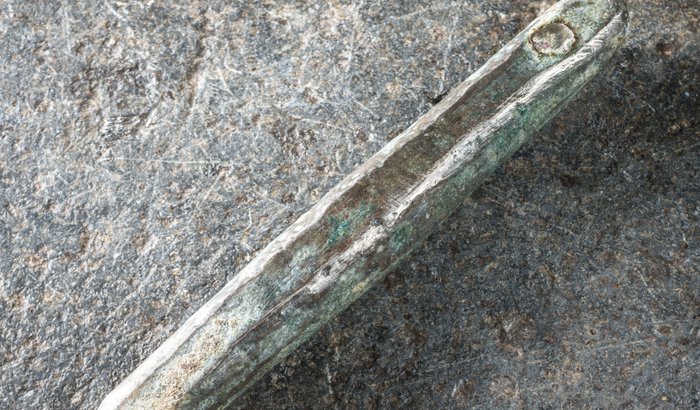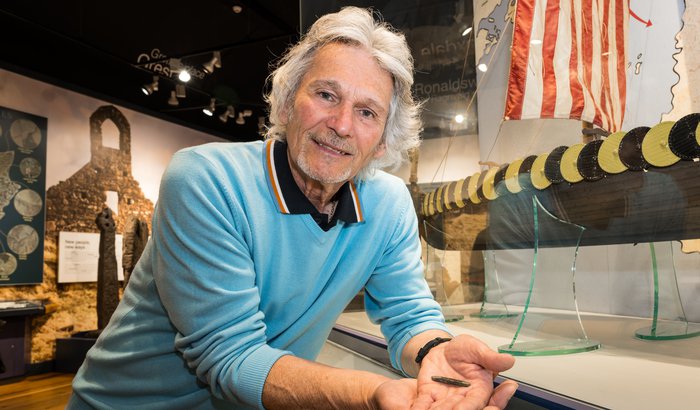

The Silver Ingot
John Smart pictured with the 1,000 year old Viking silver ingot
Situated in the heart of the Irish Sea, the Isle of Man is not only renowned for the world famous Isle of Man TT races, but also as one of the richest historic landscapes in Europe.
Today, a Viking Age silver ingot discovered on the island was declared treasure by the Isle of Man’s Coroner of Inquests. Discovered by metal detectorist John Smart, the 1,000 year old ingot weighs 10.53 grams and was discovered uncut.
During the Viking Age, silver ingots were part of a dual economy and could be used in the place of numerous silver coins as payment for goods. They are difficult to date precisely, but examples found previously on the Isle of Man range in date from around AD 900 – 1040. The ingot is the latest item of Viking Treasure discovered on the island, where more Viking Age silver has been found per square kilometre than England, Ireland, Scotland and Wales.
Similar ingots have been found in Viking Age hoards from the Island, as well as a small number of single ingots. This particular ingot is whole, but many are found cut, the remains of what was left after a financial transaction. Any find of artefacts such as this helps us to understand how the Viking Age economy operated and whereabouts on the Island activity was taking place.
Allison Fox, Manx National Heritage Curator for Archaeology said:
“Ingots like this were used in the Viking world for trade. The ingots were weighed and tested to make sure of their silver content and they were used in part or in whole to buy whatever a Viking needed. It was a cross-border currency. During the later Viking Age, ingots were used alongside coinage. This ingot may only be a small artefact, but put into context, it helps illustrate how the Isle of Man was a part of the international Viking trade network 1000 years ago including how the Viking economy operated and where on the island trade was taking place.”
In addition to silver, lead and copper were also used in ingots during the Viking Age. This particular ingot had some signs that it may have had a low silver content, so scientific analysis was carried out determine silver content and whether the ingot would fall within the definition of Treasure.
With the assistance of Dr Nicola George, Research Technical Professional for the University of Liverpool, Manx National Heritage tested the ingot with both x-ray fluorescence and a scanning electron microscope. The results showed that the ingot is composed mostly of silver, and Manx National Heritage can now say with confidence that the ingot has a silver content of over 88%.
Allison continued:
“Manx National Heritage are very grateful to both the finder and landowner for their assistance and support with this interesting find, and also to Dr George for enabling the scientific analysis”.
The ingot will go on display in the Viking and Medieval Gallery at the Manx Museum from Thursday 30 May 2024, where even more stunning Viking treasures can be discovered. The Manx Museum is open daily from 9.30am – 4.30pm. Admission is free with donations welcome.
The Isle of Man in the Viking Age
Vikings arrived on the Isle of Man in the 800s, firstly trading and eventually settling. The Vikings were a maritime people, and the position of the Island right in the centre of the British Isles meant that it was perfect as a base first for trade, then for settlement. A number of Viking Age burials have been found in the Island, both male and female. The earliest ones were buried in the pagan tradition with grave goods. The Manx Viking legacy is still very evident, not least through the modern parliament, Tynwald, which has its roots in this period. There is still plenty of Viking influence to be seen in the landscape, with castles, burial mounds and settlements all visible. Many spectacular artefacts from the Viking Age on the Isle of Man can be seen in the Manx Museum, Douglas.
The Treasure Act 2017
When finds of archaeological artefacts are made on the Isle of Man there is a legal requirement to report them to Manx National Heritage. If the artefacts fall under the categories in the Treasure Act 2017 (which include being so closely connected with Manx history and national life that their loss would be a misfortune, and/or being of outstanding significance for the study of any branch of Manx art, learning or history) the find must also be reported to the Coroner of Inquests. The Coroner decides whether or not an artefact is “Treasure”.